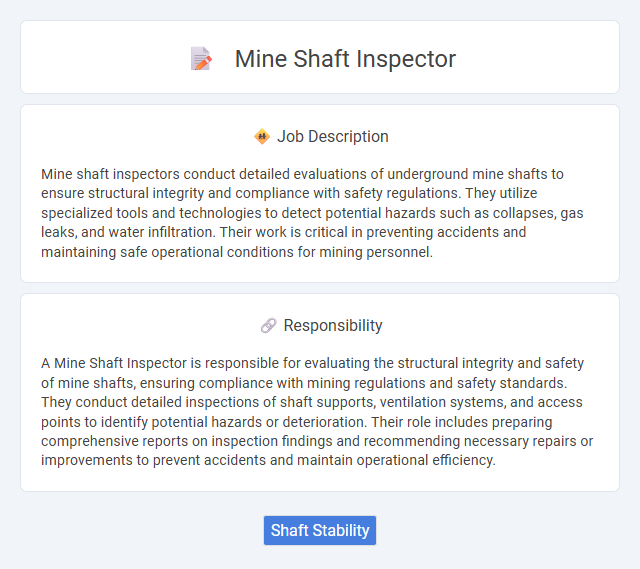
Mine shaft inspectors conduct detailed evaluations of underground mine shafts to ensure structural integrity and compliance with safety regulations. They utilize specialized tools and technologies to detect potential hazards such as collapses, gas leaks, and water infiltration. Their work is critical in preventing accidents and maintaining safe operational conditions for mining personnel.
Individuals with strong observational skills and a high tolerance for confined spaces are likely suitable for the role of a mine shaft inspector. People who experience claustrophobia or have mobility issues might find the physical demands and environment of this job challenging. It is probable that those with good physical fitness and a detail-oriented mindset would excel in ensuring safe mine shaft conditions.
Qualification
A Mine Shaft Inspector must possess a combination of technical knowledge and field experience, typically requiring a degree or certification in mining engineering, geology, or a related discipline. Proficiency in safety regulations, structural assessment, and geological surveying is essential to evaluate mine shafts for integrity and hazards. Strong analytical skills and hands-on expertise with inspection tools and technologies ensure accurate reporting and compliance with industry standards.
Responsibility
A Mine Shaft Inspector is responsible for evaluating the structural integrity and safety of mine shafts, ensuring compliance with mining regulations and safety standards. They conduct detailed inspections of shaft supports, ventilation systems, and access points to identify potential hazards or deterioration. Their role includes preparing comprehensive reports on inspection findings and recommending necessary repairs or improvements to prevent accidents and maintain operational efficiency.
Benefit
A mine shaft inspector likely ensures the safety and compliance of underground structures, reducing the risk of accidents and costly shutdowns. This role might offer benefits such as competitive salaries, health insurance, and opportunities for career advancement in the mining industry. Employees in this position probably gain valuable expertise in safety protocols and inspection technologies, enhancing their professional development.
Challenge
Mine shaft inspector roles likely involve rigorous physical and mental challenges due to the hazardous underground environment and complex structural assessments. The job probably demands precise attention to detail to identify potential safety risks and ensure regulatory compliance, which can be stressful and require specialized knowledge. Navigating confined spaces and fluctuating conditions may contribute to the overall difficulty and unpredictability of the work.
Career Advancement
Mine shaft inspectors play a crucial role in ensuring the structural integrity and safety of mining shafts through regular inspections and compliance assessments. Career advancement opportunities include progressing to senior inspector roles, safety manager positions, or transitioning into mining engineering and regulatory compliance careers. Gaining certifications such as Certified Safety Professional (CSP) or Mine Safety and Health Administration (MSHA) qualifications enhances prospects for leadership and specialized technical roles.
Key Terms
Shaft Stability
Mine shaft inspectors play a critical role in ensuring the stability and integrity of vertical mine shafts by conducting thorough assessments of structural components such as shaft linings, support systems, and wall conditions. They utilize advanced technologies like laser scanning and ground-penetrating radar to detect potential weaknesses, subsidence, or deformation that could compromise shaft safety. Regular inspections help prevent shaft collapse, safeguard miners' lives, and maintain compliance with mining regulations and industry safety standards.
 kuljobs.com
kuljobs.com